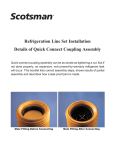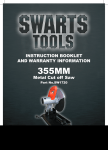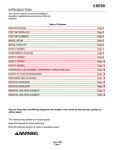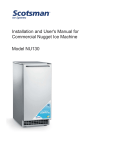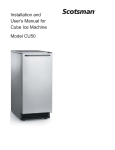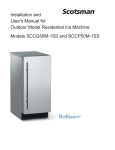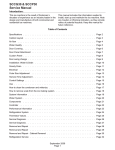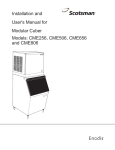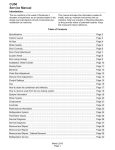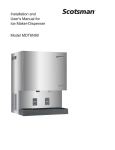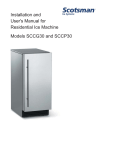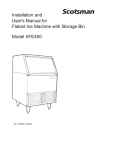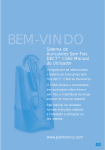Download CS60 - Scotsman Ice Systems
Transcript
CS60 INTRODUCTION This service manual covers the installation, operation, maintenance and service of this ice machine. Table of Contents INTRODUCTION . . . . . . . . . . . . . . . . . . . . . . . . . . . . . . Page 1 SPECIFICATIONS . . . . . . . . . . . . . . . . . . . . . . . . . . . . . . Page 2 FOR THE INSTALLER . . . . . . . . . . . . . . . . . . . . . . . . . . . . Page 3 FOR THE PLUMBER . . . . . . . . . . . . . . . . . . . . . . . . . . . . . Page 4 INSTALLATION . . . . . . . . . . . . . . . . . . . . . . . . . . . . . . . Page 5 INITIAL START UP . . . . . . . . . . . . . . . . . . . . . . . . . . . . . . Page 6 HOW IT WORKS: COMPONENT DESCRIPTION . . . . . . . . . . . . . . . . . . Page 7 COMPONENT LOCATION . . . . . . . . . . . . . . . . . . . . . . . . . . . Page 8 HOW IT WORKS: WATER . . . . . . . . . . . . . . . . . . . . . . . . . . . Page 9 HOW IT WORKS: REFRIGERATION . . . . . . . . . . . . . . . . . . . . . . Page 10 HOW IT WORKS: REFRIGERATION . . . . . . . . . . . . . . . . . . . . . . Page 11 OPERATION & ADJUSTMENT: OPERATING CHARACTERISTICS . . . . . . . . . . Page 12 . . . . . . . . . . . . . . . . . . . . . . . . . Page 13 SERVICE DIAGNOSIS . . . . . . . . . . . . . . . . . . . . . . . . . . . . Page 14 SERVICE DIAGNOSIS . . . . . . . . . . . . . . . . . . . . . . . . . . . . Page 15 REMOVAL AND REPLACEMENT . . . . . . . . . . . . . . . . . . . . . . . . Page 16 REMOVAL AND REPLACEMENT . . . . . . . . . . . . . . . . . . . . . . . . Page 17 SANITIZING AND CLEANING Service Parts lists and Wiring diagrams are located in the center of this manual, printed on yellow paper. This manual was printed on recycled paper. Keep this manual for future reference. Note the Warning symbol, it marks a possible hazard. January 1995 Page 1 CS60 SPECIFICATIONS 17 9/16" 28.42" 5.5" 18" 20.6" NAMEPLATE LOCATION 3/4" HOSE COUPLING THREAD POWER 25/32" 2 .2" 2 .2" 3.83" 1 .76" 5 .4" SPECIFICATIONS Model Number CS60MAS-1A Dimensions H" X W" X D" Cube Size Basic Max. Fuse Electrical Size 28.42 X 18 X 20.6 Medium 115/60/1 15 Refrigerant Charge is 12 oz of R-22. Always go by the namepate. The finish is stainless steel. Minimum circuit ampacity is used to determine wire size per national electric code. Refrigerant type is R-22. OPERATING REQUIREMENTS: MINIMUM MAXIMUM Air Temperature 0 0 50 F. 100 F. Water Temperature 400 F. 1000 F. Water Pressure 20 PSIG 100 PSIG Voltage 103.5V 126.5V Scotsman Ice Systems are designed and manufactured with the highest regard for safety and performance. They meet or exceed the standards of UL and NSF. Scotsman assumes no liability or responsibility of any kind for products manufactured by Scotsman that have been altered in any way, including the use of any parts and/or other components not specifically approved by Scotsman. Scotsman reserves the right to make design changes and/or improvements at any time. Specifications and designs are subject to change without notice. January 1995 Page 2 CS60 FOR THE INSTALLER Location: Prior consideration for the location shall include: • Air circulation: The front panel MUST remain unobstructed. Do not block with any type of • Indoors, with a minimum room temperature of 0 door or curtain. 50 F. and a maximum room temperature of 0 If the unit is built in, it will pull air in from the right 100 F. side of the front panel, and exhaust it out the left • Water temperature to the machine should be 0 0 side of the front panel. If the left side of the between 40 F. and 100 F. machine is left open, warm air will be • Service Access. Allow enough space at the discharged from the left side panel. back of the cabinet for the utilities to be connected. Allow enough space for the machine to be pulled out from its installed IF BUILT IN, THIS SIDE location. Do not build a floor in front of the SHOULD BE TIGHT AGAINST machine that would prevent its removal. THE CABINET TO PREVENT AIR RECIRCULATION COOL AIR INTAKE WARM AIR DISCHARGE January 1995 Page 3 CS60 FOR THE PLUMBER Water supply and drain connections. 1. The recommended water supply line is a 1/4" o.d. copper tube, the water pressure must have a minimum incoming pressure of 20 psig. 2. Connect the tubing to the 3/4" hose coupling thread water inlet fitting at the back of the ice maker. An optional adapter to go from the 3/4" hose coupling thread to 1/4" compression fitting is available from your dealer under part number 0533238. Or a similar adapter can be purchased from a hardware store. 3. Install a shut off valve in the incoming water line near the ice maker so that the water can be shut off for service. 4. Connect a gravity drain line to the drain connection at the ice maker. A minimum slope of 1/4" fall per foot of horizontal run is recommended. Install the drains per the local codes. A vent is recommended on the highest point of the drain tube, and the drain tubing must be rigid pipe. Do NOT use flexible tubing. POWER SUPPLY LEVEL THE UNIT POWER CORD WATER SUPPLY SHUT OFF WATER FILTER (FIELD SUPPLIED) DRAIN ADAPTER (FIELD SUPPLIED) ELECTRICAL 1. Locate the nameplate on the lower rear panel and check that the location source voltage and capacity are correct for this unit. The unit is equipped with a grounded plug connection. Under no circumstances must the ground post be altered or removed. Extension cords are not permitted. Be certain that the ice maker is connected to its own electrical circuit and is individually fused. The maximum allowable voltage variation should not exceed ten percent of the nameplate rating. All external wiring should conform to the National, State, and local electrical code requirements. Usually an electrical permit and the services of a licensed electrician will be required to install the receptacle. January 1995 Page 4 CS60 INSTALLATION FINAL CHECK 1. Is the Cabinet level? 2. Have all the electrical and piping connections been made? 3. Has the voltage been tested and checked against the nameplate rating? 4. Is the unit plugged into a separate electrical circuit? 5. Is the water supply line shut off valve installed and is the water turned on? 6. Have the bin interior, and the cabinet exterior been wiped clean? 7. Are all internal parts in place, including the spray platform and curtain? 8. Have the internal refrigerant lines been checked for rubbing and chaffing? 9. Has the machine been installed where it is indoors, in a controlled environment, with adequate air circulation around the machine, and where it can be serviced? POWER? LEVEL? DRAINS? WATER? January 1995 Page 5 CS60 INITIAL START UP If the cubes are overfilled, adjust the machine to make smaller ice cubes by turning the cube size control counter-clockwise. 1. Open water supply valve. 2. Move electrical breaker or switch to the on position. 3. Remove front panel. 4. Check the cube size control shaft, it should be in a preset cube size position. If not, turn it clockwise until the unit comes on. Note: cube size adjustments may be required. Start with the shaft in the "mid" position. 5. The machine will go thru a "dry" cycle, this will take about 10 minutes. Then the water fill and harvest cycle will begin. 6. Observe the water fill cycle: • The water inlet valve opens. • Incoming water flows from the valve through the tubing to the top of the ice maker. • Water flows around the inverted ice cube cups and drains through holes into the reservoir. • The reservoir begins to fill up with water. • Water continues to enter the machine and overflows a standpipe in the reservoir and down the drain. This will take about 3 1⁄2 minutes. After that the freeze cycle will begin. 7. Check the operation of the freezing cycle: In both cases, the next cycle of cubes harvested must be observed, and further corrections may be needed. If the ice cubes are cloudy, an extreme water condition may exist. Confirm that they are cloudy by placing them in a glass of cold water. If, in the water, they remain cloudy, you may want to have the water tested by a water treatment specialist. If the ice cubes are cloudy only on the bottom or in the center, the machine may be running out of water before the end of the freezing cycle. 10. Test the bin full shut off. To test this, hold some ice on the bin thermostat bracket (the stainless steel tube on the left side of the ice storage bin). The ice maker should stop within a few minutes of having ice on that tube. 11. Fill out the Warranty Registration and Customer Evaluation form, and mail both to Scotsman. 12. Make sure the user understands the operation and maintenance requirements for the ice maker. Leave the service manual and the name of the local Scotsman service agency with the user. • Compressor is running. • Water pump is spraying water through the spray nozzles. • Ice making begins, the water gets very cold, and ice begins to form in the cube molds. 8. Check that the plastic curtain assembly hangs down evenly in the opening and that no large streams of water are passing through. Note: Some water will drip from the reservoir as the machine runs. This is normal. 9. After about 20 minutes the machine will begin to release the ice, this is called the harvest cycle. Observe the first cube harvest: • Check the size of the ice cubes. Note: The normal size of the ice cube has a 1/4" depression in the wide end. If the cubes are not filled out, adjust the machine to make larger ice cubes by turning the cube size control shaft clockwise. January 1995 Page 6 CS60 HOW IT WORKS: COMPONENT DESCRIPTION Cube Size Control Bin Thermostat Control The cube size control is located in front of the control box, behind the front panel. The sensing capillary tube of the cube size control is routed out of the control box into its bulb holder on the evaporator coil. It is a reverse acting temperature control with double throw contacts. Turning its knob all the way counterclockwise also shuts off the ice maker. The bin thermostat control body is located in front of the control box just beside the cube size control. The thermostat sensing tube is located in the ice storage bin on the left side wall where is automatically shuts the ice maker off when the bin is full and restarts when ice is removed. Factory settings are 1 degree C (36 degrees F) cut out and 4 degrees C (39 degrees F) cut in. It can be adjusted by turning the adjustment screw visible through the control box cover. The control determines the length of the freezing cycle and correspondingly the size of the cube. A lower setting will produce a smaller cube, and a higher setting will make a larger cube. The cube size control changes its contacts when the evaporator reaches its preset temperature, starting the harvest cycle. When the sensing tube of the cube size control reaches the high preset temperature, the contacts change again, restarting the freeze cycle. Compressor Toggle Switch. The compressor toggle switch is located on the side of the control box. When moved to the ON position, it makes a circuit to the compressor. When moved to the OFF position, the other components will still operate. Water Pump The water pump operates during the freezing cycle only, pumping water through the spray nozzles into the inverted spray cups. Hot Gas Valve Assembly The hot gas valve assembly is comprised of two parts, the valve body and the coil. These parts are located on the discharge line of the compressor and are activated by the cube size control (harvest cycle). When the coil of the hot gas valve is energized, it magnetically lifts the plunger in the hot gas valve body. This allows hot refrigerant gas to by-pass the condenser and go directly to the evaporator. Spray Platform and Chute The spray system used on this unit is of the stationary type. The water is forced by the water pump into the platform chamber and sprayed into the inverted cup molds through a set of six spray nozzles. Fan Motor Inlet Water Solenoid Valve The water solenoid valve, located in the back panel of the unit, is energized only during the harvest or cleaning cycles. When energized it allows a metered amount of water to flow into the machine (.21 g.p.m.) This water flows to the top of the evaporator and then down into the reservoir. The fan motor is electrically connected through the cube size control and runs only during the freezing cycle. Hermetic Motor Compressor The compressor is a vapor pump, forcing refrigerant gas throughout the refrigeration system. January 1995 Page 7 CS60 COMPONENT LOCATION SPRAY PLATFORM EVAPORATOR RESERVOIR FILL TUBE WATER PUMP WATER RESERVOIR BIN DRAIN BIN LEVEL CONTROL TUBE BIN THERMOSTAT CONTROL BOX HOT GAS VALVE CUBE SIZE & ON/OFF WATER INLET VALVE COMPRESSOR CLEANING SWITCH January 1995 Page 8 CS60 HOW IT WORKS: WATER Freezing cycle The refrigeration process creates cold temperatures within the evaporator coils and removes heat from the water sprayed up into the inverted ice cube cups. When enough heat is removed, the water changes into ice, and forms where it is the coldest: in the ice cube cups. Minerals contained in the supply water will not freeze and are drained away. Mostly pure water will be frozen into the ice cubes. During the freezing cycle, the compressor, fan motor, and water pump are operating. Water is continuously freezing or being sprayed and recirculated. When evaporator temperature is lowered to the cold temperature setting of the cube size control, it ends the freezing cycle and starts the harvest cycle. The cube size control thermostat senses the warmer temperatures of the harvest cycle, and at a preset temperature, opens the circuit to the hot gas and inlet water valves. Both valves then close. The harvest cycle is complete, and the freezing cycle restarts. The automatic ice making process continues until the bin is full of ice, and the bin thermostat senses a colder temperature. The bin thermostat then opens the circuit to all components and the automatic ice making process stops. WATER TO EVAPORATOR Harvest cycle The hot gas valve opens and hot refrigerant gas is discharged into the evaporator. The inlet water valve opens and a fresh supply of water flows to the top of the evaporator and then drains into the reservoir. WATER SPRAY WATER PUMP, ON DURING FREEZE The ice cubes have been released INLET WATER from the inverted cube cups in the evaporator by the warming effect of the VALVE, OPEN DURING hot refrigerant gas condensing in the HARVEST evaporator tubing, plus the incoming water flowing around the inverted cups. The released ice cubes drop onto the spray platform and through the curtain assembly into the ice storage bin. DRAINS January 1995 Page 9 CS60 HOW IT WORKS: REFRIGERATION FREEZE CYCLE From the condenser, the liquid refrigerant flows through the liquid line, and the liquid line filter-drier. After the filter drier, the liquid refrigerant enters the metering device, a capillary tube. After passing the restriction of the capillary tube, the refrigerant enters an area of relative low pressure, the evaporator. In the tubing of the evaporator, the liquid refrigerant expands and evaporates, absorbing heat from the evaporator tubing and anything in contact with it such as water sprayed against it. The ice cubes are formed in an inverted mold that is refrigerated. The refrigeration process begins at the compressor. There, refrigerant vapor is compressed and flows from the compressor through the discharge line as a high temperature, high pressure gas. In the discharge line there is a strainer with two outlets, one leads to the condenser, and one to a solenoid valve. Because the solenoid valve is closed, the gas flows to the condenser, where heat is transferred from the refrigerant to the air passing through the condenser. The refrigerant then condenses into a high pressure liquid. The refrigerant, now a low pressure, low temperature vapor, flows into the accumulator, which traps excess liquid refrigerant. The vapor, now primarily a gas, goes through the suction EVAPORATOR ACCUMULATOR CAPILLARY TUBE DISCHARGE LINE SUCTION LINE CONDENSER LIQUID LINE STRAINER COMPRESSOR Refrigeration System Schematic January 1995 Page 10 FILTER-DRIER CS60 HOW IT WORKS: REFRIGERATION hot gas valve to the evaporator, where the ice cubes are frozen. HARVEST CYCLE (When the cubes are released) At the evaporator, the high temperature gases are cooled by the cold temperatures of the cube mold, and condense into liquid, transferring heat to the mold which warms up and releases the cubes. The ice cubes have been formed in an inverted mold that was refrigerated. Now the refrigeration system will change to warm the cube mold and release the cubes. The process begins at the compressor. There, refrigerant vapor is compressed and flows from the compressor through the discharge line as a high temperature, high pressure gas. Before the gas gets to the condenser,it goes through a strainer, the strainer outlet is connected to two tubes, one of which leads to an electric valve, the hot gas solenoid. When this valve opens, the refrigerant gas follows the path of least resistance and flows through the tubing from the The refrigerant, now a low pressure, low temperature vapor, flows into the accumulator, which traps excess liquid refrigerant. The vapor, now primarily a gas, goes through the suction line tube to the compressor where the cycle is repeated. EVAPORATOR ACCUMULATOR CAPILLARY TUBE SUCTION LINE CONDENSER DISCHARGE LINE HOT GAS SOLENOID (OPEN) LIQUID LINE COMPRESSOR STRAINER FILTER-DRIER January 1995 Page 11 CS60 OPERATION & ADJUSTMENT: OPERATING CHARACTERISTICS The information shown below covers a wide range of air and water temperatures. It is intended as a guideline only, and is based on data compiled from NEW CLEAN units. Allow a variation from each end of the range given. A. Refrigeration system pressures: B. Freeze cycle time 20 minutes High Side (discharge) C. Defrost cycle time 2- 3 minutes End of Freeze cycle 150 - 160 psig D. Compressor amps Harvest cycle 100 - 125 psig Freeze cycle 4 to 3.4 Low side (suction) Harvest cycle 3.8 to 4.1 End of Freeze cycle 10 - 11 psig Harvest cycle (maximum) 90 psig ADJUSTMENT OF THE CUBE SIZE: Adjust only when cubes are too big or small. (See the illustration at the right.) 1. Remove front panel, locate knob. 2. To increase the size, turn knob 1/8 turn clockwise. To make the cubes smaller, turn the knob 1/8 turn counterclockwise. 3. Observe the size of the cubes in the next two harvest cycles, if more adjustment is needed, continue adjustments until the correct size is obtained. CORRECT SIZE ADJUSTMENT OF THE BIN THERMOSTAT CONTROL Adjust the bin thermostat when the ice maker turns off too soon (ice level low) or when it turns off too late (ice storage bin overfills.) To increase the ice level in the storage bin: TOO SMALL, LITTLE OR NO ICE IN THE CENTER OF THE Rotate the bin thermostat adjustment screw (located under front panel on control box cover) clockwise one eight turn at a time until the ice level that the machine maintains is correct. To decrease the ice level in the storage bin: Rotate the bin thermostat adjustment screw counterclockwise one eight turn at a time until the ice level is correct. TOO BIG, THICK BULGE OF SOLID ICE ON THE END. January 1995 Page 12 CS60 SANITIZING AND CLEANING A Scotsman Ice System represents a sizable investment of time and money in any company’s business. In order to receive the best return for that investment, it MUST receive periodic maintenance. It is the USER’S RESPONSIBILITY to see that the unit is properly maintained. The following is a list of recommended maintenance that will help keep the machine running with a minimum of problems. Maintenance and Cleaning should be scheduled at a minimum of twice per year. General The periods and procedures for maintenance and cleaning are given as a guide. Cleaning will vary depending upon local water conditions and the amount of ice used. Each ice maker must be maintained individually, in accordance with its own requirements. 8. Then switch the cleaning toggle switch to the "cleaning" position for about three minutes to release all the ice cubes from their cups. 9. Switch the cleaning toggle switch to the "operation" position, and allow the machine to run for 30 minutes, or until the next batch of ice is released into the bin. 10. Pour hot water into the bin to melt the ice produced during cleaning, and to clean out the drain. Wipe the interior of the bin with mild soap and hot water, rinse with cold water. Icemaker In Place Cleaning 1. Remove the ice from the bin. 2. Remove front panel. 3. Rotate control knob counter clockwise to the Off position. 4. Remove curtain by pulling forward on the left end, and then pulling the curtain to the left and out of the machine. 5. Lift up spray platform, locate stand pipe to the right of the opening, and pull it out to drain the reservoir. Replace the standpipe, spray platform, and curtain. 6. Mix approximately 3 ounces (1⁄10 liter) of Scotsman Ice Machine Cleaner with 1.5 quarts (1.5 liter) of warm (95-115oF.) potable water, and pour this solution into the reservoir at the curtain base. Scotsman Ice Machine Cleaner contains acids. These compounds may cause burns. If swallowed, DO NOT induce vomiting. Give large amounts of water or milk. Call Physician immediately. In case of external contact, flush with water. To sanitize, mix a locally approved sanitizer solution and repeat steps 3-10, except substitute the sanitizer solution for the ice machine cleaner solution. A possible sanitizer solution may be obtained by mixing 1 ounce of household bleach with 2 gallons of warm (95-115oF) water. Caution: Do not use the ice produced during cleaning, as it may have a strong acid content. 11. Replace the front panel. Ice maker Maintenance 1. Shut off water supply to the ice maker. 2. Disconnect the water inlet tube from the connection at the back of the ice maker, and check the screen at that point. If very dirty, carefully pull the screen out and clean it. Reassemble water line to ice maker. 3. Open the water shut off valve. 4. Unplug the power cord to disconnect electrical power to the ice maker. 5. Remove the front panel. 6. Clean the air-cooled condenser fins using a vacuum, whisk broom, brush, or if needed, coil cleaner. The ice making capacity of this machine is reduced by a dirty condenser coil. 7. Rotate the control knob to the "normal" position. Operate the machine for 20 minutes. January 1995 Page 13 CS60 SERVICE DIAGNOSIS SYMPTOM Unit will not run POSSIBLE CAUSE Blown fuse or breaker Compressor cycles intermittently Low voltage Dirty condenser Air circulation blocked around unit Non condensable gas in system Cubes too small Cloudy cubes Irregular size cubes, some cloudy Cubes too large Decreased ice capacity Low Ice Capacity SUGGESTED CORRECTION Replace fuse & check for cause of blown fuse, reset breaker. Check voltage at the supply to the building. Check circuit for overloading. Clean the condenser Allow sufficient air around unit Evacuate and recharge with nameplate charge Cube size control set too warm Check and adjust for proper operation Partially restricted cap tube Blow charge, evacuate with new drier, weigh in nameplate charge Moisture in system Same as above Overcharged Same as above Undercharged Same as above, look for a leak. Spray nozzles plugged Clean Needs cleaning Clean with Scotsman Ice Machine Cleaner Some jets plugged Clean jets Shortage of water Check water supply Cube size control set improperly Check and adjust for proper operation Inefficient compressor Replace Leaky inlet water Replace valve Non-condensable gas in the Replace refrigerant system High Head Pressure Dirty condenser, Worn fan motor, High air temperature High water temperature High air temp Relocate machine or water line. Overcharge Replace the refrigerant Restricted system Replace the drier and refrigerant January 1995 Page 14 CS60 SERVICE DIAGNOSIS SYMPTOM Poor harvest No harvest Excessive water in ice storage bin POSSIBLE CAUSE Too short defrost Not enough water Hot gas valve does not work Inlet water valve plugged Air and water temp too low Cube size control does not work Hot gas valve does not work Water inlet valve does not work Drain plugged January 1995 Page 15 SUGGESTED CORRECTION Replace cube size control Check water supply Replace Clean or replace Try to change location Replace Replace Replace Clean drain CS60 REMOVAL AND REPLACEMENT Cube Size Control 1. Unplug the ice maker to disconnect electrical power. Electrical Shock Hazard. Disconnect electrical power before beginning. Bin Thermostat 1. Unplug the ice maker to disconnect electrical power. 2. Remove screws and cabinet front panel. 3. Remove screws and control box cover, disconnect electrical wires from bin thermostat control. 4. Dismount bin thermostat from the control box 5. Remove rear panel. 6. Pull bin thermostat capillary line from tube in ice storage bin. Remove complete control from ice machine. 7. Replace with new control in reverse order of removal. 2. Remove screws and cabinet top, front, and rear panels. 3. Pull knob from cube size control shaft. Remove screws and control box cover to gain access to the cube size control body. Remove screws and dismount cube size control from control box. Disconnect electrical wires from cube size control. 4. At the top of the machine, unclip cube size thermostat tube holder from evaporator, (retain clips and tube assembly.) Pull cube size control capillary tube from the tube, and remove complete cube size control from the ice maker. 5. Insert capillary tube on new thermostat into tube holder, be sure that the end caps are in place. 6. Reverse the removal procedures to reinstall the cube size control. Adjust as needed. Refrigeration System Any time the refrigeration system is opened, the drier must be replaced, the system evacuated and the exact charge measured into the system. Any other procedure is NOT CORRECT, and will result in substandard performance. Cube Size Control Tube. Locate and Secure in its Original Position Cube Size Control January 1995 Page 16 CS60 REMOVAL AND REPLACEMENT Water Inlet Valve Electrical Shock Hazard. Disconnect electrical power before beginning. 1. Unplug the ice maker to disconnect electrical power. 2. Shut off water supply to ice maker. 3. Remove the lower back panel, pull out to expose inlet water valve. 4. Disconnect electrical wires from inlet water valve. 5. Disconnect water lines to and from water valve. Spray Platform 1. Open ice bin door. 6. Remove valve from ice maker. 2. Pull out on the left side and remove curtain assembly. 7. Reverse removal procedure to replace. 3. Lift the spray platform up and pull out to get to the water hose at the base of the platform. 4. Pull hose off of connection to spray platform, and pull platform from ice maker. 5. To replace, reverse the removal procedures. INLET WATER VALVE CURTAIN Water Pump 1. Disconnect ice maker from electrical power. 2. Remove top panel. 3. Open ice bin door pull up through top and remove. 4. Remove curtain by pulling forward and out on the left end. 5. Remove 2 screws holding pump bracket to right side panel. 6. Disconnect 2 electrical leads and 1 ground wire from pump. 7. Pull out spray platform, lift pump and disconnect hose. 8. Pull water pump up and out of ice maker. 9. Dismount water pump from cover assembly (retaining the brackets), and remount the replacement pump in its place. 10. Reverse the balance of the steps to reassemble. January 1995 Page 17

















